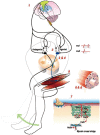Sarcopenia: Neurological Point of View
- PMID: 28642851
- PMCID: PMC5472802
- DOI: 10.11005/jbm.2017.24.2.83
Sarcopenia: Neurological Point of View
Abstract
Sarcopenia is an age-related geriatric syndrome which is characterized by the gradual loss of muscle mass, muscle strength, and muscle quality. There are a lot of neurologic insults on sarcopenia at various levels from the brain to the neuromuscular junctions (NMJs) to generate a volitional task. Dopaminergic downregulation, inadequate motor programming and motor coordination impairment lead to decline of supraspinal drive. Motor unit reorganization and inflammatory changes in motor neuron decrease conduction velocity and amplitude of compound muscle action potential. Furthermore, NMJ remodeling and age related neurophysiological alterations may contribute to neuromuscular impairment. Sarcopenia is an age-associated, lifelong process which links to multiple etiological factors. Although not all the causes are completely understood, we suggest that compromised nervous system function may be one of the important contributors to the sarcopenia.
Keywords: Aging; Motor neurons; Nervous system; Neuromuscular junction; Sarcopenia.
Conflict of interest statement
No potential conflict of interest relevant to this article was reported.
Figures




References
Publication types
LinkOut - more resources
Full Text Sources
Other Literature Sources

